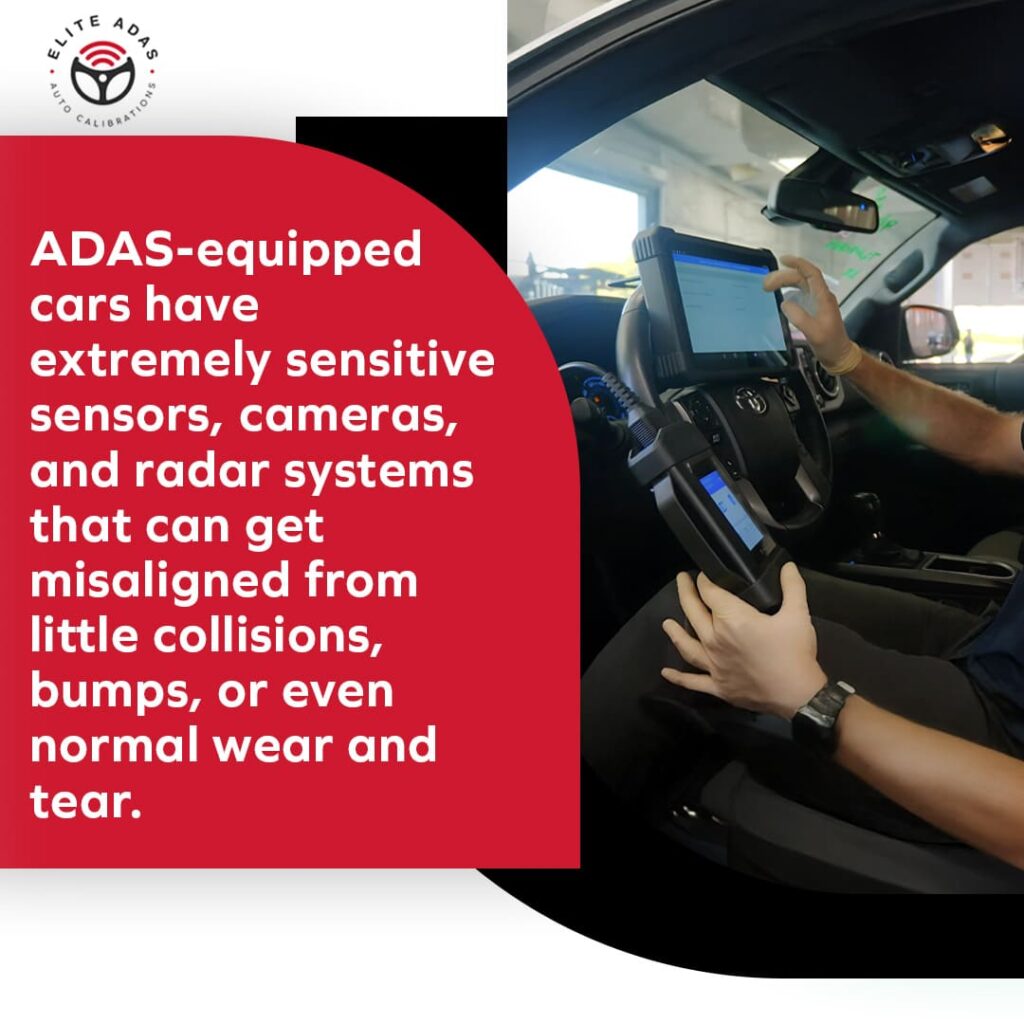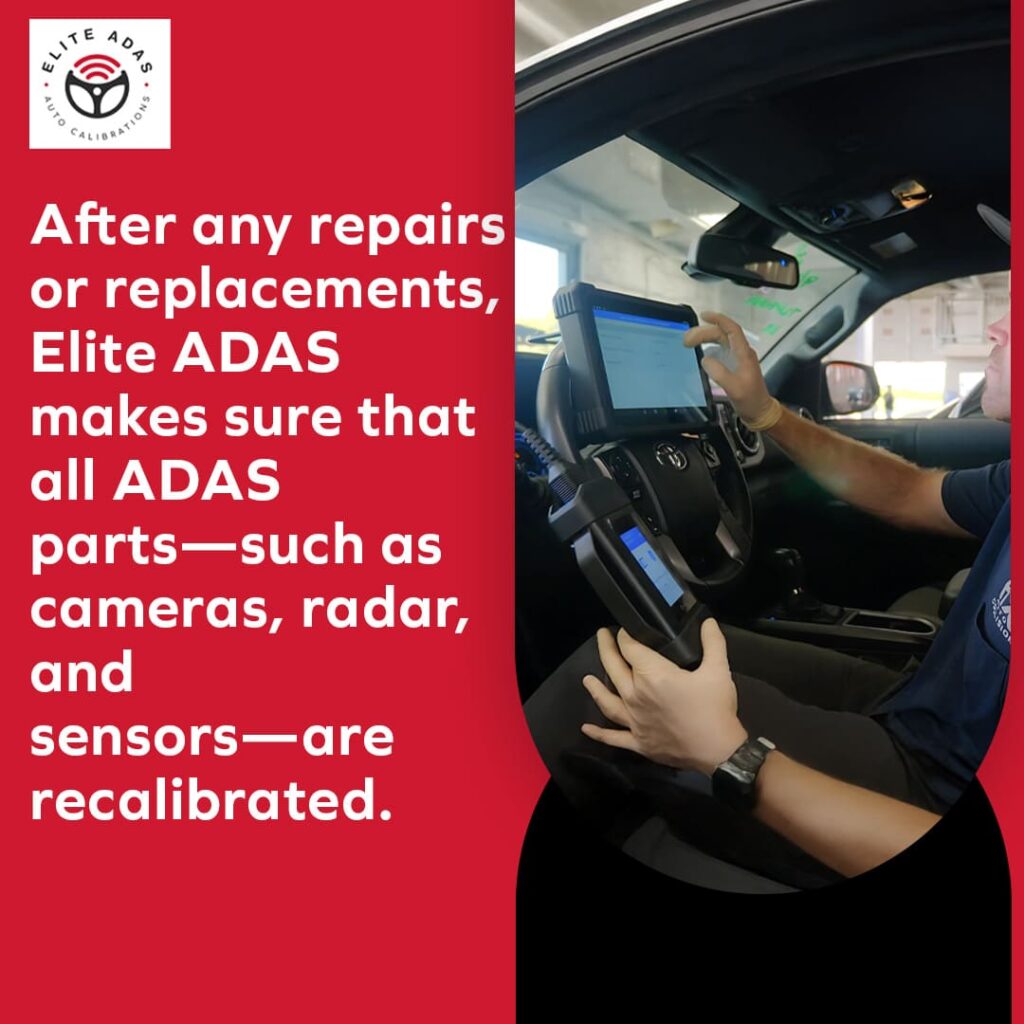When purchasing a used car with Advanced Driver Assistance Systems (ADAS), it’s important to check the condition of features like lane-keeping assist, automatic emergency braking, and adaptive cruise control. These systems rely on sensors, cameras, and software that can wear out over time or require costly repairs.
Buyers should understand how ADAS functions and confirm that all components are in good working order. Proper calibration is essential for accurate performance, as misaligned sensors can cause system failures. Before making a purchase, inspect the vehicle’s ADAS calibration history and verify that all systems are fully operational.
Elite ADAS recommends checking the condition of cameras, sensors, and software. Regular maintenance and professional inspections help prevent malfunctions and expensive repairs. Inaccurate sensor readings can create safety risks, making proper calibration a key factor when considering a used vehicle with ADAS.

The Need for Proper ADAS Calibration Prior to Purchasing a Used Car
Calibration plays an important role when buying a used vehicle equipped with ADAS technology. These systems rely on sensors, including cameras, radar, and ultrasonics, to monitor surroundings, detect obstacles, and adjust driving responses in real-time. Over time or after an accident, these sensors may become misaligned, affecting how the system functions. Incorrect readings can impact safety features and lead to serious driving risks.
For example, if the lane-keeping assist system is not properly calibrated, the vehicle may fail to detect lane markings, increasing the chance of drifting into another lane. Similarly, an improperly adjusted adaptive cruise control system may struggle to maintain a safe following distance, raising the risk of a rear-end collision.
This is where professional ADAS calibration becomes essential. Elite ADAS in Rocklin, CA, provides precise and efficient calibration services for various systems, including cameras, radar, and sonar. Whether a vehicle needs calibration for windshield cameras, lane-keeping assist, or collision detection sensors, Elite ADAS aligns each component to meet manufacturer specifications.
Calibration involves adjusting sensors and cameras to maintain proper alignment and functionality as recommended by the manufacturer. This process requires specialized tools, expertise, and a thorough understanding of ADAS technology. Depending on the vehicle make and model, calibration may involve manual adjustments or advanced ADAS calibration equipment that syncs with onboard systems. Any repair or maintenance that affects ADAS components—such as windshield replacement or collision repairs—requires recalibration to restore accurate operation. Elite ADAS in Rocklin, CA, provides expert calibration services to keep ADAS features working correctly, improving safety, accuracy, and reliability.
Effects of Sensor Damage on ADAS Performance in Used Cars
Checking a vehicle’s sensor history is essential when purchasing a used car equipped with Advanced Driver Assistance Systems (ADAS). If the car has been involved in an accident or sustained damage, verifying that the front or rear sensors were properly calibrated after repairs is necessary. Failing to do so can result in inaccurate sensor readings, affecting system reliability and overall safety.
For example, a faulty automatic emergency braking system may fail to detect obstacles, including other vehicles or objects. If the system does not respond correctly, it increases the risk of collisions that could have been avoided with a fully functional ADAS. Incorrect sensor readings may also disable key functions like lane-keeping assist or adaptive cruise control, reducing their effectiveness.
Regular calibration after any sensor-related repairs helps maintain the accuracy of these advanced safety features. Sensor degradation in used vehicles can impact ADAS performance, as these systems rely on precise data to assist with lane-keeping, adaptive cruise control, and collision prevention. If a radar or camera sensor malfunctions, the system may struggle to detect objects correctly, limiting its ability to respond in real-time.
Routine ADAS calibration plays a key role in keeping sensors properly aligned and functioning as intended. Even minor sensor issues can lead to unpredictable ADAS behavior, weakening driver assistance features and reducing overall vehicle safety.
ADAS Calibration Tools and Professional Calibration
Calibrating an ADAS system is not a simple task. Specialized tools and equipment are required to align and adjust sensors, cameras, and radar systems accurately. Professional calibration centers use advanced technology to fine-tune these systems according to manufacturer specifications, allowing them to function correctly. Features such as lane departure warnings, adaptive cruise control, and collision avoidance rely on proper calibration to work as intended. Misaligned sensors can lead to incorrect readings, reducing the effectiveness of driver assistance features and overall vehicle safety.
When purchasing a used vehicle equipped with ADAS, check whether it has undergone recent professional calibration. Certified technicians, like those at Elite ADAS in Rocklin, CA, use advanced instruments to test system functionality and align sensors for accurate performance. This process helps prevent errors that could lead to hazardous situations, such as failing to detect obstacles or responding incorrectly in emergencies.
Calibration tools are expensive and require specialized knowledge for proper use. If considering a pre-owned vehicle with ADAS, factor in potential calibration costs. After an accident or significant repair, recalibration may be necessary to restore system accuracy. It is also helpful to inquire about future calibration and repair expenses, as these can impact long-term ownership costs. Proper calibration and maintenance help keep ADAS features functioning as designed, contributing to overall vehicle safety.
The Risks of Inaccurate ADAS Sensor Readings in Used Vehicles
When buying a used vehicle with ADAS technology, it is essential to consider how incorrect sensor readings may affect safety. Modern Automotive ADAS relies on a network of cameras, sensors, and radar to support functions such as lane-keeping assist, adaptive cruise control, blind-spot monitoring, and automatic emergency braking. These features help improve driving safety and convenience, but they only function correctly when the supporting components are properly calibrated.
Misalignment or damage to these sensors can lead to inaccurate readings. Even minor accidents, such as a fender bender, can cause misalignment that may go unnoticed if not corrected. Simple incidents like running over a curb or parking bumper can also disrupt radar sensor or camera calibration, resulting in faulty data. This can affect critical safety features, such as blind-spot monitoring failing to detect nearby vehicles or lane departure warnings not recognizing lane markers. These issues become even more dangerous in heavy traffic or at high speeds, where quick decisions are necessary.
Proper ADAS calibration helps prevent these problems. Realigning sensors, cameras, and radar systems according to manufacturer specifications is a key step in maintaining accuracy. If a vehicle has undergone repairs such as bumper or windshield replacement, confirm that the ADAS system has been recalibrated. Incorrect readings due to improper calibration can reduce the effectiveness of these safety systems.
When purchasing a used vehicle with ADAS, always check its history, particularly for past accidents or repairs that may have affected the system. Reviewing calibration and repair records provides insight into the condition of these components.
During a test drive, verify that all ADAS features are working as expected. These technologies must be accurately calibrated and fully functional to operate correctly. Routine maintenance and recalibration help maintain long-term reliability and safety.
The Costs and Factors to Consider for ADAS Calibration in Used Cars
The more advanced a vehicle’s ADAS features are, the higher the potential cost for repairs and calibration. A car equipped with multiple ADAS systems—such as lane departure warning, collision warning, adaptive cruise control, and parking sensors—may require several calibration steps to confirm that all systems function correctly. Calibration can take time and be expensive, especially when dealing with misalignment issues or the need for sensor replacement. For those buying a used car with ADAS technology, understanding these costs is important, as they may become the owner’s responsibility.
A thorough inspection of ADAS components before purchasing a used car helps verify that the systems are in good working order. Request a detailed vehicle history report that includes any sensor modifications, repairs, or accidents. Reliable sellers provide full documentation on the ADAS system and the car’s overall condition. If there are concerns about system accuracy, ask the seller to arrange for a qualified technician to inspect and recalibrate it. Elite ADAS offers professional calibration services, aligning vehicle sensors and cameras to OEM standards for proper functionality.

Additional factors to keep in mind when purchasing a used vehicle with ADAS
Vehicle History Report
Always request a detailed vehicle history report to check for previous incidents or repairs. Even minor collisions can affect the performance of a car’s ADAS sensors and cameras, leading to misalignment or damage. Reviewing the vehicle’s history helps determine whether its safety systems are functioning correctly. Keep records of any ADAS calibrations or repairs, as errors can impact system performance, driver assistance features, and overall safety.
Pre-Purchase Inspection
Before finalizing the purchase of a used vehicle, have it thoroughly inspected by a mechanic with expertise in automotive ADAS systems. These technologies rely on cameras and sensors to assist with various driving functions. A qualified professional can confirm that the ADAS components are calibrated correctly and operating as intended. Even if a vehicle appears undamaged, its sensors may have been displaced or compromised in a prior accident. A comprehensive inspection can help identify potential concerns, preventing costly repairs down the line. The mechanic can also verify whether the system has undergone the necessary calibration to function properly.
Testing ADAS Features
Taking a used vehicle for a test drive allows you to assess the performance of its ADAS features in real-world conditions. Pay attention to how adaptive cruise control, lane-keeping assist, automatic emergency braking, and other driver assistance functions respond. These systems rely on precise sensor data, and any inconsistencies could indicate calibration or alignment issues. A malfunction in these features may pose safety risks. If any system does not operate correctly, a professional should conduct a detailed assessment to determine whether recalibration or repairs are needed.
Checking Calibration Records
Service records related to past ADAS calibration and repairs are essential when considering a used vehicle with these features. Proper calibration is necessary to align cameras and sensors correctly. Request documentation of any calibration services performed on the car. These records provide insight into the system’s maintenance history and help confirm whether it has been properly maintained. If no calibration history is available, the system may not have been serviced, increasing the likelihood of inaccurate sensor readings or operational issues.
Ongoing Maintenance
After purchasing a used vehicle with ADAS, regular maintenance should be a priority. These systems rely on cameras and sensors that can become misaligned or damaged over time. Routine calibration checks should be included in your vehicle maintenance plan. Even minor impacts can affect ADAS functionality. Be prepared for potential recalibration costs, as adjustments may be required following component replacements or repairs. Regular inspections help keep the ADAS system operating as intended, contributing to overall vehicle safety.
Final Thoughts
Purchasing a used vehicle equipped with ADAS technology can be a smart investment for both safety and driving convenience. However, understanding the complexity of these advanced systems is essential. Proper calibration and maintenance are necessary to keep them functioning correctly. Before making a purchase, check the condition of the sensors, review the calibration history, and consider ADAS Calibration Insurance for added security.
By considering these factors and using professional calibration services from Elite ADAS, you can make an informed decision that helps maintain the safety and performance of your vehicle’s ADAS features. Whether your car includes adaptive cruise control, lane-keeping assist, or automated emergency braking, verifying the condition and functionality of these systems will help keep your vehicle operating safely for years to come.
Elite ADAS in Rocklin, California, provides expert calibration and maintenance services to keep your vehicle’s ADAS technology performing at its best. Their skilled team delivers reliable service to keep your systems operating as intended. For professional calibration support, contact (916) 471-4606 or reach out via email at [email protected].
